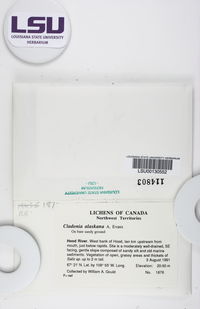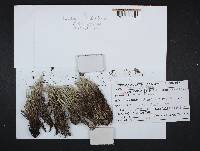
Consortium of Lichen Herbaria
- building a Global Consortium of Bryophytes and Lichens as keystones of cryptobiotic communities -
- Home
- Search
- Images
- Species Checklists
- US States: O-Z >
- US National Parks
- Central America
- South America
- US National Parks
- Southern Subpolar Region
|
|
|
|
Family: Cladoniaceae
|
Thompson, J., 1984. American Arctic Lichens: The Macrolichens. Primary thallus unknown. Podetia forming compact tufts, dying at the base and growing from the apices, branching irregularly by dichotomies or in whorls of 3 or 4, the branches ascending closely to each other; axils open or closed; podetial wall often split, 40-80 mm tall and up to 2 mm in diameter; the surface not at all glossy, somewhat arachnoid under a lens; pale gray tinged with yellowish or brownish tints, darker in older parts; the cartilaginous layer forming a continuous hollow cylinder around the central canal and forming a series of irregular bulges projecting into this canal; this layer sharply delimited from the outer medullary layer in which the algal clusters are located near the periphery in a single discontinous layer covered by the cortex; few small squamules on the podetia, up to 1 mm long and undivided or little lobed, rounded at apex; branches bearing the apothecia larger than the sterile branches and irregularly divided and split in the upper part, thus perforate at the apices but without actual cups. Apothecia 1-2 mm in diameter; clustered or confluent around the apical perforations; pale to dark brown. Pycnidia at the apices of the podetia. Reactions: K+ vaguely yellowish turning to gray, KC+ yellow. P+ red. Contents: usnic and fumarprotocetraric acids plus accessory ursolic acid. This species grows in lichen heath tundras, tussock tundras, and over boulders in tundras. It is an American endemic as far as currently known although it may actually be an amphi-Beringian element member as Krog (1968) mentions a Siberian specimen. It ranges from Alaska and the Yukon eastward in the tundras to the Thelon River and Churchill areas. |
Powered by Symbiota














